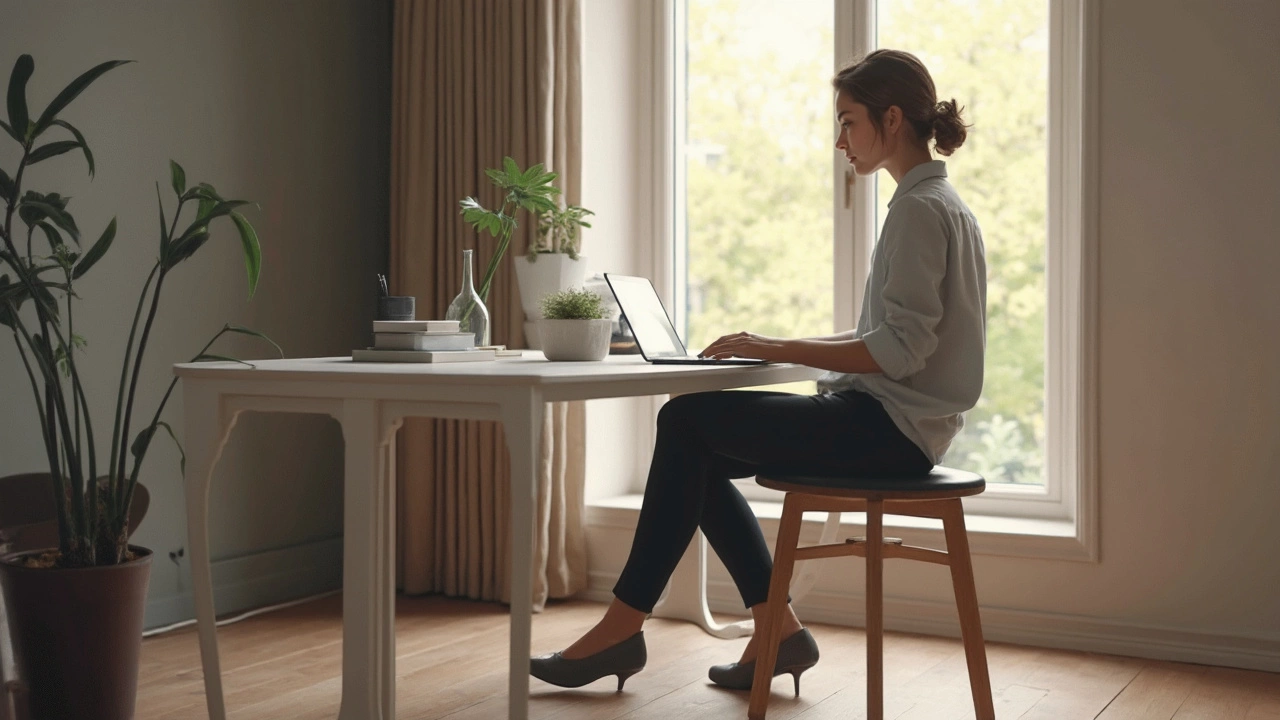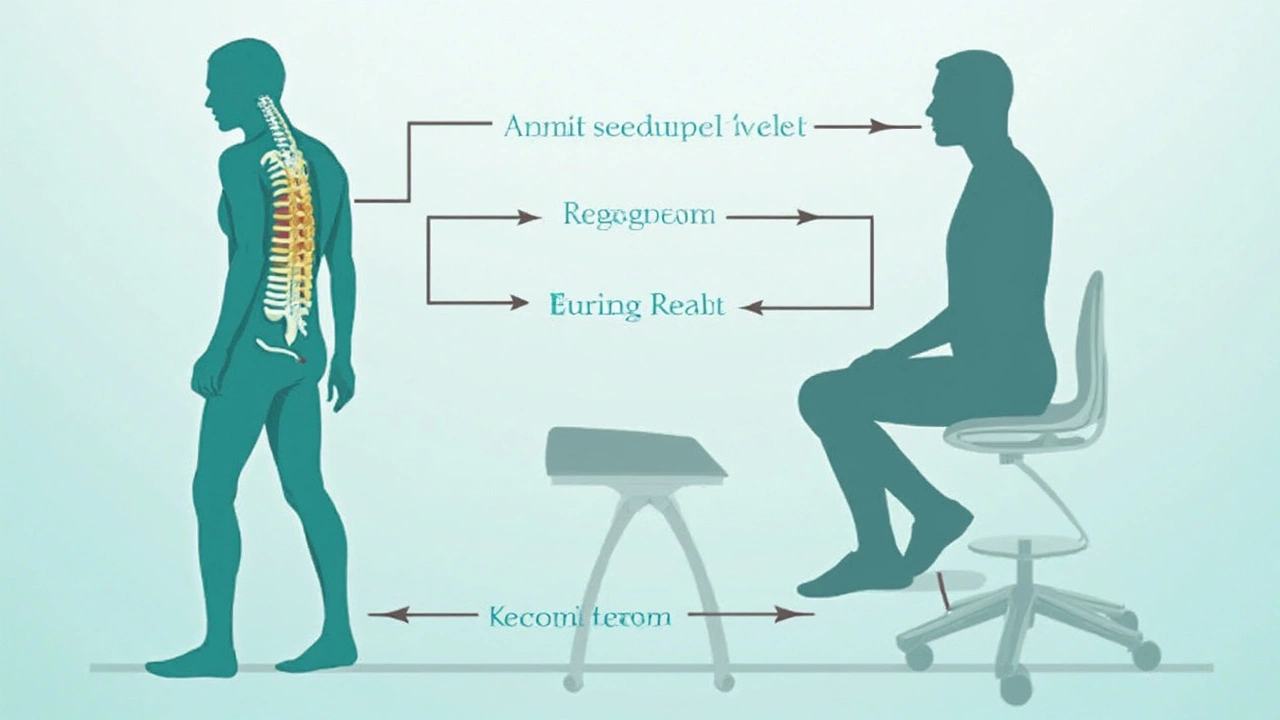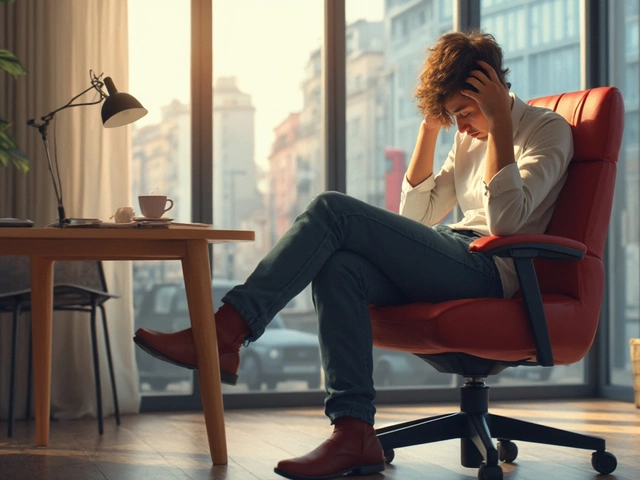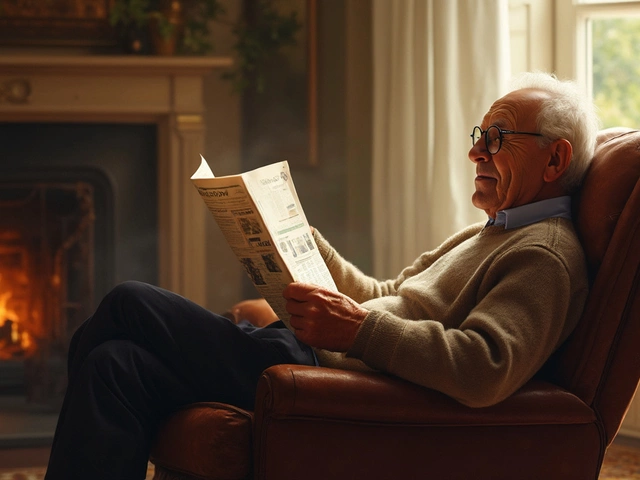 27
Mar,2025
27
Mar,2025
Sitting on a stool might seem like a straightforward choice in your workspace setup, but have you ever wondered about its effect on your back? Well, you're not alone. There's more to stools than meets the eye, especially when it comes to posture and spine health.
One thing about stools is they force you to sit upright, a good thing at first glance. But without back support, that perch can challenge your posture over time. You might find yourself fighting to maintain a straight back, which can be both a blessing and a curse.
Stools don't just test your posture—they can play a role in back pain too. If you haven't thought about the repercussions, it's time to start. In the next sections, we'll dig deeper into how stools interact with our bodies, and more importantly, how you can make that work in your favor.
- Understanding Stool Design
- Impact on Posture
- The Back Pain Connection
- When Stools Are Beneficial
- Tips for Stool Sitters
- Alternatives to Consider
Understanding Stool Design
So, what's the deal with stools? On the surface, they seem like the simplest piece of furniture—a flat seat perched atop some legs. But there’s more going on beneath the simplicity, and it’s worth knowing if you're spending long hours on one.
The basic design of a stool hasn’t changed much over the years. Most stools ditch the luxury of a backrest altogether. That means if you opt for one, you're relying on your core muscles to keep you upright. This design can either enhance your posture by engaging those muscles or make it tough on your back if you're not careful.
| Stool Feature | Impact on Back |
|---|---|
| Lack of Backrest | Requires strong core to maintain posture |
| Height Adjustability | Essential for proper alignment |
| Footrest | Reduces pressure on legs |
Now, let’s talk about height adjustability. The ideal stool lets you tweak the height to match your workstation. This customization is crucial for minimizing strain on your back and ensuring your thighs are parallel to the ground.
Some stools come with footrests, a feature that’s more important than you might think. Supporting your feet can prevent excess pressure on the backs of your legs and help distribute your weight more evenly.
Lastly, materials matter. A padded seat might seem like a minor detail, but in reality, it can make a world of difference in comfort, especially during longer work sessions. Whether it’s leather, fabric, or cozy cushion, the right seat can make or break your stool experience.
Impact on Posture
Sitting on a stool doesn’t come with the lumbar support many of us are used to in the typical office chair. Sounds simple, right? But it has a decent impact on how your back and spine behave. When there's no supportive backrest, you need to engage your core muscles to keep your upper body straight.
This can be a double-edged sword. While engaging those muscles is good practice, it can become tiring if maintained for long periods. It's like doing an extended plank without a break. Over time, some people might start slouching forward—goodbye, healthy spine alignment! Regular slouching could increase the pressure on your lower back, possibly leading to discomfort or pain.
Interestingly, a small study found that workers who used stools with no back support ended up shifting their sitting positions significantly more throughout the day. While shifting is a natural response to discomfort, consistent posture changes aren't always kind to the spine either.
So what's the upshot? Recognize the need for frequent posture checks if you're part of the stool-sitting club. Here are a few quick tips to keep your posture in check:
- Take breaks to stand and stretch every 30 minutes.
- Periodically engage in standing or walking meetings when possible.
- Incorporate seated exercises that fit your workspace.
Remember, using a stool means being proactive about your posture to harness those core-strengthening benefits while keeping your back pain at bay.
The Back Pain Connection
Alright, let's talk about how sitting on a stool might lead to some unwanted back pain. Unlike office chairs that support your lower back, stools usually don't come with any kind of backrest. This means your back muscles have to work overtime just to keep you upright.
Without that crucial support, your spine can start to slouch, and that's where the trouble begins. Poor posture over time might lead to chronic backaches or even long-term issues like spinal misalignment.
Research shows that folks who sit for long periods, especially on non-ergonomic seating like stools, are more prone to back issues. A study from 2022 found that prolonged periods without proper lumbar support increased the occurrence of back pain by about 40%.
| Sitting Condition | Reported Back Pain |
|---|---|
| Stool with No Back Support | High (70%) |
| Chair with Back Support | Low (20%) |
The key here is moderation. If you're finding that your back starts to ache after sitting on a stool for a while, it might be time to reassess how you use it. Take regular breaks, stretch it out, and maybe give your spine a rest by switching to a chair with better back support from time to time.
It's not all black and white, though. Sitting on a stool might actually help strengthen your core if done in moderation. But remember, too much of anything isn't good for you—or your back.

When Stools Are Beneficial
You might be surprised, but there are times when sitting on a stool can actually be good for you. It's all about how you use it and what tasks you're doing. Let's get into some specifics and see where stools can shine.
First off, stools are fantastic for jobs or hobbies that require moving around frequently. Picture working at a counter or lab, where you need to lean over and swivel around regularly. A stool lets you do all that without the hassle of getting up and down all the time. It's about efficiency and convenience.
Another perk is the way stools can help encourage a more active sitting posture. With no backrest, you're kind of nudged to engage your core muscles more. This might not be everyone's cup of tea, but if you're looking to strengthen those core muscles just a bit while seated, a stool could be your secret weapon.
Stools aren't just practical for work. Think about home bars or kitchens. Ever notice how social and lively these places feel when stools are part of the setup? They're great for creating a casual, informal vibe where people can gather and chat without fuss.
Here's something neat: a 2023 survey found that 62% of artists and design professionals prefer stools for tasks needing rapid position changes.* Cool, right?
Ultimately, a stool isn't the devil it's sometimes made out to be. For the right activities and environments, it could help you stay engaged and, dare we say, even a bit productive. Just be savvy about your stool choice and remember to listen to your body.
*Survey conducted by Arts and Artists Inc., 2023
Tips for Stool Sitters
If you've chosen a stool as your seating buddy, you might be wondering how to avoid back pain and make sure you're getting the best out of your choice. No worries—I've got some simple tips to help keep your back happy while you perch.
First things first, posture is your friend. Keep your feet flat on the ground to maintain stability and to lessen the pressure on your spine. When your feet are firmly planted, you're less likely to slouch or hunch over.
Next, pay extra attention to the height of your stool. Ideally, your hips should be slightly above your knees. This helps keep your spinal alignment in check. You don't want to be perched too high or hunched too low.
Consider adding a footrest. Giving your feet a place to rest can go a long way in managing comfort. It distributes your body weight more evenly, reducing stress on your lower back.
- Do yourself a favor and stretch regularly. Set a timer if you need to so you remember to change positions or stand up every 30 minutes or so. It's amazing what a little stretch can do.
- Don't forget about cushioning. A seat cushion can make a big difference, especially if your stool is hard or flat, providing a bit more support for your tailbone.
- If you're using a stool at work, consider alternating between standing and sitting. A sit-stand desk could be a good investment for your overall comfort and health.
Finally, let's talk about back support. Some stools come with optional backrests, which can be a game-changer. If yours doesn't, consider sneaking a small pillow behind your lower back for some support.
Alternatives to Consider
If you’re questioning the long-term comfort of a stool, you’re probably curious about other seating options that might be better for your back. Let's dive into some worthy contenders that might just replace your stool in the office.
Firstly, there's the classic ergonomic chair. These are basically the Swiss Army knives of seating. They come equipped with adjustable features like lumbar support and height adjustment, which can be tailored specifically to your body. Dr. Paul Roberts, a posture expert, says,
"An ergonomic chair can significantly reduce the risk of back pain by promoting proper spine alignment."
Another cool option is a kneeling chair. It might look a bit odd, but it can help balance the weight across your body and encourages an open hip angle, which can reduce pressure on the lower back. So if you’re feeling adventurous, this could be an option.
Don't forget about standing desks. They're all the rage in modern offices. By alternating between sitting and standing, you can keep your body more active, which could help in preventing that dreaded back pain. Many find this dynamic way of working pretty beneficial.
Here's a quick list of seating choices that could suit different needs:
- Ergonomic chair - For adjustable comfort.
- Kneeling chair - To share weight between knees and buttocks.
- Exercise ball chair - Keeps the core engaged.
- Standing desk - For alternating sitting and standing.
- Saddle seat - For open hip angles resembling horseback riding.
Each option has its pros and cons, so you'll want to think about what’s most important for your back and posture before making the switch. It's worth experimenting until you find the right match for your workspace. Your back will thank you for it!




